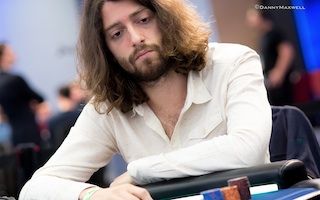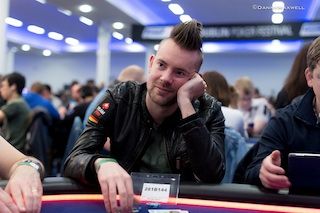When the Card That Improves Your Hand Isn’t Good for You

Comparisons of poker to sports are quite common. The recent efforts of the new Global Poker League with its city-based teams and frequent mentioning of “sportifying” the game have kept that discussion alive.
Even so, there are many characteristics of poker that make it different from most sports. The lack of an athletic component is probably the most obvious. There’s another difference, however, one that was well illustrated, in fact, during one of the GPL heads-up matches this week.
Winning By a Little = Winning Big
In most sports, individuals or teams strive to score as much as possible, wanting to build big, comfortable leads over their opponents in order to increase the chance of victory. But in a hand of poker, it is often preferable not to make hands that are overwhelmingly better than those your opponents hold, but rather just slightly ahead so as to improve your chances of getting more value from those hands by winning bigger pots.
In other words — speaking mainly of hands that go to showdown — it is often better in poker to win by a little, so to speak, because your opponent is more apt to pay off more with strong second-best hands than with hands that are obviously crushed.
We can’t control what cards are dealt, of course, and so we can’t really force the issue when it comes to managing our hand strength. But recognizing this fact about poker — that the value of our hand is directly affected by the value of what our opponent’s have — can help us recognize what cards are good for us, what are not so good, and how to play our hands going forward.
A Good-Bad Flop for Kurganov
The GPL hand that brought up this difference between a poker hand and, say, a game of basketball, came during the first heads-up contest between George Danzer (representing the Paris Aviators) and Igor Kurganov (of the London Royals). It was the first hand of the match — and, as it turned out, the only hand of the match, as it ended with Danzer managing to claim all of Kurganov’s stack.
The players had stacks of 50,000 to start with the blinds 200/400 with a 40 ante. Danzer was dealt J♥10♠ on the button and raised to 1,000. Kurganov meanwhile had picked up A♠A♣ and so three-bet to 3,600.
Both players were on webcams, speaking to the viewers but not to each other. That meant we could see Danzer grin and exclaim “first hand!” as he saw Kurganov’s three-bet. We could also see Kurganov smiling as well, saying into the camera “So obvious that I’m three-betting the first hand, right George?” and hoping Danzer would doubt his three-bet meant a genuinely strong holding.
“This is a fine hand to call a three-bet with,” Danzer concluded after a moment’s thought, and called the reraise. Both watched the flop come A♦K♣4♠.

While Danzer had little reaction to that flop, we could see Kurganov looked a little disheartened, even making an “oof” noise and grimacing a little. But he had made top set of aces! He’d improved his hand as much as he possibly could with that flop, in fact. Why the disappointment?
Commentator Griffin Benger provided an explanation.
“Almost disappointed, Igor, that he flopped that well,” said Benger. “Hard to get action on this texture.”
With pocket aces, Kurganov didn’t mind the rainbow flop (three different suits) and relatively dry board. But he would much rather have seen a raggedy flop with no ace. With such a strong pocket pair in the hole, he didn’t need to improve his hand on the flop in order to have what would likely be the strongest hand. Thinking also about the range of hands with which Danzer would call the preflop three-bet, the ace (and the king, for that matter) appeared likely to snuff out any action Kurganov might get going forward.
If this were an NBA playoff game, Kurganov had taken an early lead when he was dealt the pocket aces. Now suddenly he was up by 20 late in the third quarter, with those “Win Probability” calculators you sometimes see used in sports now rating him a heavy favorite to remain in the lead to the end.
According to the PokerNews Poker Odds Calculator, Kurganov set of aces made him better than 86% likely to finish with the best hand against Danzer’s then-unimproved jack-ten. Even without knowing Danzer’s hand, Kurganov knew he was similarly way ahead of just about anything his opponent could have. Too far ahead, even.
A Delightful Turn of Events for Danzer
Kurganov bet small — 1,890 into the 7,280 pot — and with a shrug Danzer called, saying “I’ve got a gutshot, right?”
The immediate pot odds (calling 1,890 to win 9,170, or about 4.85-to-1) made it okay for Danzer to call and chase his four outs (four queens) for a Broadway straight. And the implied pot odds further justified the decision, given that if a queen did come, Danzer would have a good chance to win a lot more than what was already in the middle.

Also making the call less difficult to make was the fact that if Danzer did improve to straight, there’d be zero doubt he’d have the best current hand. Whereas Kurganov didn’t necessarily want to improve on the flop, Danzer absolutely knew he had to improve on the turn or he’d have an easy fold to Kurganov’s next bet.
Alas for Kurganov, the Q♣ did fall on the turn, and after Kurganov bet 6,800, Danzer raised to 16,730.
Now Danzer was in the position we were describing above with regard to Kurganov — holding a very strong hand (the strongest possible) and hopeful his opponent had something nearly as strong. In fact, Danzer was more than just hopeful — he had a good idea from Kurganov’s action he could have hands like ace-king or ace-queen for two pair, or a premium pocket pair for a set.
His hand too good to fold, Kurganov called. It was a “close” game, so to speak, with just one card to come, greatly favoring the team in the lead.
The river was a blank — the 2♦ — and Kurganov ultimately check-called Danzer’s river shove of 28,740 to lose the match. Again, it was an ideal situation for Danzer, with both players having strong hands and him being just slightly ahead of his opponent. (You can watch the hand on the GPL site by clicking here.)
Conclusion
Poker tournaments are like other sports in a way, in that in a tournament it is obviously good to build a big lead over your opponents and increase your chance of winning.
But in a single hand, having a “big lead” in terms of relative hand strength isn’t usually going to earn you much action. And while every victory by an NBA team is worth exactly the same regardless of the final score, poker hands are of varying value as determined by the size of the pot.
In hands that go to showdown, you’re more likely to win big when your “lead” is small — a difference between poker and sports worth keeping in mind when deciding whether or not cards that improve your hand are in fact good for you.
Want to stay atop all the latest in the poker world? If so, make sure to get PokerNews updates on your social media outlets. Follow us on Twitter and find us on both Facebook and Google+!









